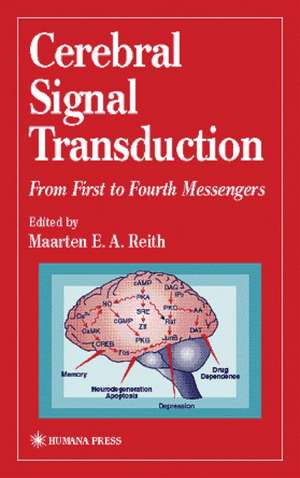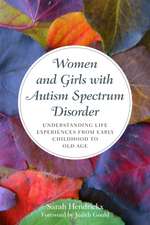Cerebral Signal Transduction: From First to Fourth Messengers: Contemporary Neuroscience
Editat de Maarten E.A. Reithen Limba Engleză Hardback – 16 feb 2000
| Toate formatele și edițiile | Preț | Express |
|---|---|---|
| Paperback (1) | 950.52 lei 6-8 săpt. | |
| Humana Press Inc. – 20 iul 2012 | 950.52 lei 6-8 săpt. | |
| Hardback (1) | 957.94 lei 6-8 săpt. | |
| Humana Press Inc. – 16 feb 2000 | 957.94 lei 6-8 săpt. |
Din seria Contemporary Neuroscience
- 5%
 Preț: 1128.63 lei
Preț: 1128.63 lei - 18%
 Preț: 965.52 lei
Preț: 965.52 lei - 5%
 Preț: 1108.35 lei
Preț: 1108.35 lei - 18%
 Preț: 1228.15 lei
Preț: 1228.15 lei - 18%
 Preț: 1229.73 lei
Preț: 1229.73 lei - 18%
 Preț: 1231.64 lei
Preț: 1231.64 lei - 18%
 Preț: 945.47 lei
Preț: 945.47 lei - 18%
 Preț: 1244.08 lei
Preț: 1244.08 lei - 15%
 Preț: 638.76 lei
Preț: 638.76 lei - 18%
 Preț: 1240.47 lei
Preț: 1240.47 lei - 18%
 Preț: 1385.99 lei
Preț: 1385.99 lei - 18%
 Preț: 1227.84 lei
Preț: 1227.84 lei - 18%
 Preț: 1220.88 lei
Preț: 1220.88 lei - 18%
 Preț: 961.55 lei
Preț: 961.55 lei - 15%
 Preț: 695.70 lei
Preț: 695.70 lei - 18%
 Preț: 959.82 lei
Preț: 959.82 lei - 5%
 Preț: 1112.17 lei
Preț: 1112.17 lei - 18%
 Preț: 1233.83 lei
Preț: 1233.83 lei - 18%
 Preț: 950.96 lei
Preț: 950.96 lei - 24%
 Preț: 799.51 lei
Preț: 799.51 lei - 18%
 Preț: 954.77 lei
Preț: 954.77 lei - 18%
 Preț: 1227.21 lei
Preț: 1227.21 lei - 5%
 Preț: 1117.46 lei
Preț: 1117.46 lei - 18%
 Preț: 1248.02 lei
Preț: 1248.02 lei - 18%
 Preț: 949.10 lei
Preț: 949.10 lei - 5%
 Preț: 1114.35 lei
Preț: 1114.35 lei - 15%
 Preț: 694.22 lei
Preț: 694.22 lei - 18%
 Preț: 950.52 lei
Preț: 950.52 lei - 5%
 Preț: 1124.07 lei
Preț: 1124.07 lei - 5%
 Preț: 1117.10 lei
Preț: 1117.10 lei - 24%
 Preț: 1089.45 lei
Preț: 1089.45 lei - 18%
 Preț: 1227.52 lei
Preț: 1227.52 lei - 18%
 Preț: 955.08 lei
Preț: 955.08 lei - 5%
 Preț: 1417.38 lei
Preț: 1417.38 lei
Preț: 957.94 lei
Preț vechi: 1168.21 lei
-18% Nou
Puncte Express: 1437
Preț estimativ în valută:
183.32€ • 199.06$ • 153.99£
183.32€ • 199.06$ • 153.99£
Carte tipărită la comandă
Livrare economică 23 aprilie-07 mai
Preluare comenzi: 021 569.72.76
Specificații
ISBN-13: 9780896036086
ISBN-10: 0896036081
Pagini: 428
Ilustrații: XII, 428 p. 105 illus.
Dimensiuni: 155 x 235 x 29 mm
Greutate: 0.8 kg
Ediția:2000
Editura: Humana Press Inc.
Colecția Humana
Seria Contemporary Neuroscience
Locul publicării:Totowa, NJ, United States
ISBN-10: 0896036081
Pagini: 428
Ilustrații: XII, 428 p. 105 illus.
Dimensiuni: 155 x 235 x 29 mm
Greutate: 0.8 kg
Ediția:2000
Editura: Humana Press Inc.
Colecția Humana
Seria Contemporary Neuroscience
Locul publicării:Totowa, NJ, United States
Public țintă
ResearchCuprins
I. Introduction.- 1 • From First to Fourth Messengers in the Brain: An Overview.- II. Memory.- 2 • Cellular and Molecular Mechanisms of Learning and Memory.- 3 • Signal Transduction Pathways in Well-Defined Models of Learning and Memory: Drosophila and Honeybee.- 4 • Protein Kinase C Signaling in Learning and Memory.- III. Neurodegeneration and Apoptosis.- 5 • Neurotransmitter Receptor—G-Protein-Mediated Signal Transduction in Alzheimer’s Disease.- 6 • The NO Signaling Pathway in the Brain: Neural Injury, Neurological Disorders, and Aggression.- 7 • Cellular Signaling Pathways in Neuronal Apoptosis: Role in Neurodegeneration and Alzheimer’s Disease.- 8 • The Role of Second Messengers in Neurodegeneration.- IV. Depression.- 9 • Molecular and Cellular Determinants of Stress and Antidepressant Treatment.- 10 • Long-Term Bidirectional Hormonal and Neuroplastic Responses to Stress: Implications for the Treatment of Depression.- 11 • Signal Transduction Abnormalities in Bipolar Affective Disorder.- V. Drug Dependence.- 12 • Messengers in Opioid Dependence: Gene Disruption Studies.- 13 • The 5-HT1B Knockout Mouse: An Animal Model of Vulnerability to Drugs of Abuse.- 14 • Regulation of Dopamine Transporter by Phosphorylation and Impact on Cocaine Action.- 15 • Dopamine Transporter mRNA in Human Brain: Distribution and Regulatory Effects in Autopsy Studies of Cocaine Abusers.
Recenzii
"The editor states the goal is to offer a comprehensive picture of recent advances made in the signaling field as it relates to neuronal and cerebral function. . . The editor and the contributors accomplished the goal remarkably well. The chapters are arranged so that clinical and laboratory investigations on depression, bipolar disorder, and drug dependence follow more basic research on memory, apoptosis, and degeneration. Each chapter is extremely well referenced, making this a valuable reference source. Multiple black-and-white illustrations, drawings, and microphotographs enhance the text quality...This new volume in the series Contemporary Neuroscience may serve as an excellent overview of current knowledge in the field of cerebral signaling and transduction."-Doody's Health Science Book Review Journal
"The quality of each of the chapters of this book is outstanding and will provide valuable information for a variety of neuroscientists."- Journal of Molecular Neuroscience
"The quality of each of the chapters of this book is outstanding and will provide valuable information for a variety of neuroscientists."- Journal of Molecular Neuroscience
Textul de pe ultima copertă
In Cerebral Signal Transduction: From First to Fourth Messengers, Maarten E.A. Reith and a team of leading experts comprehensively review and synthesize the most recent advances in our understanding of the role of cerebral signaling in neuronal and cerebral function. The authors emphasize the functional role of the various signaling pathways in memory, apoptosis and degeneration, depression, and drug dependence in both health and diseases states. The signaling pathways discussed include cAMP/PKA, Ca2+/calmodulin-dependent protein kinase, DAG/PKG, and neurotrophic factor signaling cascades. By taking full advantage of the newfound ability to selectively remove, reduce, or enhance specific components of the signaling pathways, the investigators writing here illuminate the varied signaling cascades, their crosstalk, and the many possibilities for changes in gene expression underlying long-term changes in brain function.
Cutting-edge and comprehensive, Cerebral Signal Transduction: From First to Fourth Messengers advances our understanding of the mechanistic underpinnings of complex behavioral processes and clinically relevant brain diseases. A major contribution to the development of the novel pharmacotherapeutics targeting downstream events in the cascade of second, third, and fourth messengers, it will serve experimental and clinical neuroscientists as today's best and most complete guide to neuronal signaling.
Cutting-edge and comprehensive, Cerebral Signal Transduction: From First to Fourth Messengers advances our understanding of the mechanistic underpinnings of complex behavioral processes and clinically relevant brain diseases. A major contribution to the development of the novel pharmacotherapeutics targeting downstream events in the cascade of second, third, and fourth messengers, it will serve experimental and clinical neuroscientists as today's best and most complete guide to neuronal signaling.
Caracteristici
Includes supplementary material: sn.pub/extras













